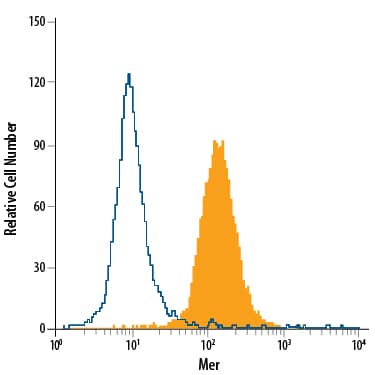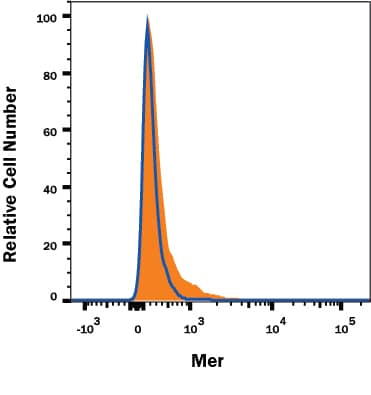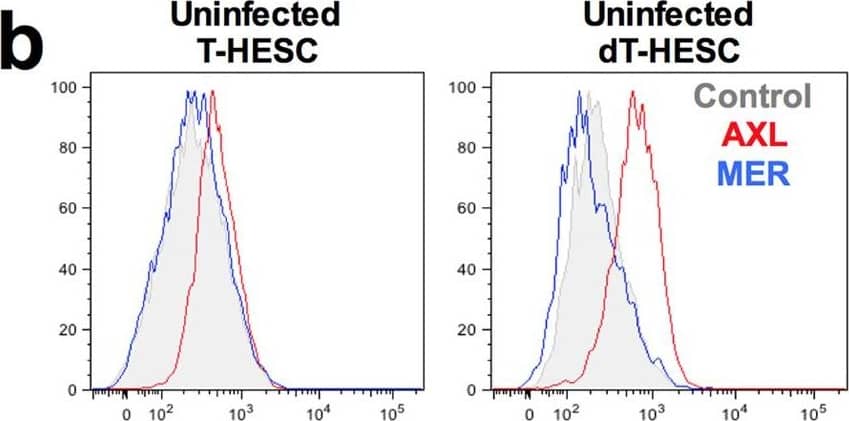Human Mer Antibody
R&D Systems, part of Bio-Techne | Catalog # MAB8912


Key Product Details
Validated by
Species Reactivity
Validated:
Cited:
Applications
Validated:
Cited:
Label
Antibody Source
Product Specifications
Immunogen
Met1-Ala499
Accession # AAB60430
Specificity
Clonality
Host
Isotype
Scientific Data Images for Human Mer Antibody
Detection of Mer in HepG2 Human Cell Line by Flow Cytometry.
HepG2 human hepatocellular carcinoma cell line was stained with Mouse Anti-Human Mer Monoclonal Antibody (Catalog # MAB8912, filled histogram) or isotype control antibody (Catalog # MAB0041, open histogram), followed by Phycoerythrin-conjugated Anti-Mouse IgG Secondary Antibody (Catalog # F0102B).Detection of Mer in U937 Human Cell Line by Flow Cytometry.
U937 human histiocytic lymphoma cell line was stained with Mouse Anti-Human Mer Monoclonal Antibody (Catalog # MAB8912, filled histogram) or isotype control antibody (Catalog # MAB0041, open histogram), followed by Phycoerythrin-conjugated Anti-Mouse IgG Secondary Antibody (Catalog # F0102B).Mer Specificity is Shown by Flow Cytometry in Knockout Cell Line.
Mer knockout HepG2 human hepatocellular carcinoma cell line was stained with Mouse Anti-Human Mer Monoclonal Antibody (Catalog # MAB8912, filled histogram) or isotype control antibody (Catalog # MAB0041, open histogram) followed by anti-Mouse IgG PE-conjugated secondary antibody (Catalog # F0102B). No staining in the Mer knockout HepG2 cell line was observed. View our protocol for Staining Membrane-associated Proteins.Applications for Human Mer Antibody
CyTOF-ready
Flow Cytometry
Sample: HepG2 human hepatocellular carcinoma cell line and U937 human histiocytic lymphoma cell line
Knockout Validated
Sample: Mer is specifically detected in HepG2 human hepatocellular carcinoma parental cell line but is not detectable in Mer knockout HepG2 cell line.
Human Mer Sandwich Immunoassay
Reviewed Applications
Read 2 reviews rated 4.5 using MAB8912 in the following applications:
Formulation, Preparation, and Storage
Purification
Reconstitution
Formulation
Shipping
Stability & Storage
- 12 months from date of receipt, -20 to -70 °C as supplied.
- 1 month, 2 to 8 °C under sterile conditions after reconstitution.
- 6 months, -20 to -70 °C under sterile conditions after reconstitution.
Background: Mer
Axl (Ufo, Ark), Dtk (Sky, Tyro3, Rse, Brt) and Mer (human and mouse homologues of chicken c-Eyk) constitute a receptor tyrosine kinase subfamily. The extracellular domains of these proteins contain two Ig-like motifs and two fibronectin type III motifs. This characteristic topology is also found in neural cell adhesion molecules and in receptor tyrosine phosphatases. These receptors bind the vitamin K-dependent protein growth-arrest-specific gene 6 (Gas6) which is structurally related to the anticoagulation factor protein S. Binding of Gas6 induces receptor autophosphorylation and downstream signaling pathways that can lead to cell proliferation, migration or the prevention of apoptosis. Recent studies suggest that this family of tyrosine kinase receptors may be involved in hematopoiesis, embryonic development, tumorigenesis and regulation of testicular functions.
References
- Nagata, K. et al. (1996) J. Biol. Chem. 22:30022.
- Crosier, K.E. and P.S Crosier (1997) Pathology 29:131.
Long Name
Alternate Names
Gene Symbol
UniProt
Additional Mer Products
Product Documents for Human Mer Antibody
Product Specific Notices for Human Mer Antibody
For research use only


